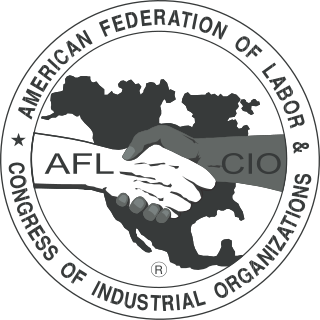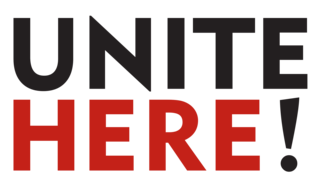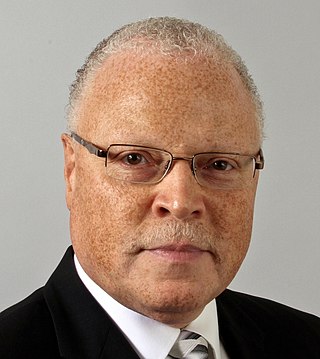
The American Federation of Labor and Congress of Industrial Organizations (AFL-CIO) is a national trade union center that is the largest federation of unions in the United States. It is made up of 60 national and international unions, together representing more than 12 million active and retired workers. The AFL-CIO engages in substantial political spending and activism, typically in support of progressive and pro-labor policies.
The United Food and Commercial Workers International Union (UFCW) is a labor union representing approximately 1.3 million workers in the United States and Canada in industries including retail; meatpacking, food processing and manufacturing; hospitality; agriculture; cannabis; chemical trades; security; textile, and health care. UFCW is affiliated with the Canadian Labour Congress (CLC) and the AFL–CIO; it disaffiliated from the AFL–CIO in 2005 but reaffiliated in 2013. UFCW is also affiliated to UNI Global Union and the IUF.

Service Employees International Union (SEIU) is a labor union representing almost 1.9 million workers in over 100 occupations in the United States and Canada. SEIU is focused on organizing workers in three sectors: healthcare, including hospital, home care and nursing home workers; public services ; and property services.

John Joseph Sweeney was an American labor leader who served as president of the AFL–CIO from 1995 to 2009.
Jerome Wurf was a U.S. labor leader and president of the American Federation of State, County and Municipal Employees (AFSCME) from 1964 to 1981. Wurf was a friend of Martin Luther King Jr., and was arrested multiple times for his activism, notably during the Memphis sanitation strike. He was present for King's "I've Been to the Mountaintop" oratory at the strike, the day before King was assassinated, and attended King's funeral.

UNITE HERE is a labor union in the United States and Canada with roughly 300,000 active members. The union's members work predominantly in the hotel, food service, laundry, warehouse, and casino gaming industries. The union was formed in 2004 by the merger of Union of Needletrades, Industrial, and Textile Employees (UNITE) and Hotel Employees and Restaurant Employees Union (HERE).

The Strategic Organizing Center (SOC), formerly known as the Change to Win Federation (CtW), is a coalition of North American labor unions originally formed in 2005 as an alternative to the AFL–CIO. The coalition is associated with strong advocacy of the organizing model. The coalition currently consists of Service Employees International Union (SEIU), the United Farm Workers (UFW), and the Communications Workers of America (CWA), the latter of which is affiliated with both the SOC and the AFL–CIO.
Anna Burger was the Secretary-Treasurer of Service Employees International Union (SEIU) and Chair of the Change to Win Federation.

1199: The National Health Care Workers' Union was an American labor union founded as the Drug, Hospital, and Health Care Employees Union-District 1199 by Leon J. Davis for pharmacists in New York City in 1932. The union organized all workers in drug stores on an industrial basis, including pharmacists, clerks, and soda jerks. The union led pioneering pickets and strikes against racial segregation and racially discriminatory hiring in Harlem and elsewhere in New York City during the 1930s.
The Labor Council for Latin American Advancement (LCLAA) is a nonprofit, nonpartisan Latino organization affiliated with the AFL-CIO and the Change to Win federation. It was founded in 1972 to provide Latino trade union members in the United States with a more effective voice within the AFL-CIO, to encourage Latino participation in the democratic process, and to encourage the organization of Latino workers into labor unions.

Gerald William McEntee was an American trade union official. He served as president of the American Federation of State, County and Municipal Employees (AFSCME), an affiliate of the AFL-CIO, from 1981 to 2012.

The Memphis sanitation strike began on February 12, 1968, in response to the deaths of sanitation workers Echol Cole and Robert Walker. The deaths served as a breaking point for more than 1,300 African American men from the Memphis Department of Public Works as they demanded higher wages, time and a half overtime, dues check-off, safety measures, and pay for the rainy days when they were told to go home.
Richard Webster Cordtz was an American labor leader. From 1980 to 1995, he was the International Secretary-Treasurer of the Service Employees International Union under John Sweeney, and was president of the union himself from October 1995 to May 1996.
George Hardy was a Canadian-American labor leader who was president of the Service Employees International Union (SEIU) from 1971 to 1980. At the time of his death, SEIU had grown to become the fifth-largest affiliate of the AFL-CIO. Hardy was a vice president of the AFL-CIO from 1972 to 1980, and a member of its executive council. He was a former member of the Democratic National Committee and the California Democratic State Central Committee.

Mary Kay Henry is an American labor union activist who was elected International President of the Service Employees International Union (SEIU) on May 8, 2010. She is the first woman to lead the union. While serving with the union in California, she helped pioneer SEIU's use of card check agreements, non-traditional collective bargaining agreements, comprehensive campaigns, and system-wide health care organizing strategies. Henry was included on Time's 100 Most Influential People of 2020.

United EMS Workers-AFSCME Local 4911 is a labor union representing EMS workers. Members include Emergency Medical Technicians, paramedics, registered nurses, vehicle service technicians, Emergency Medical Dispatchers, and 911 schedulers.
The 2009 election for the leadership of the AFL–CIO occurred following the announcement of incumbent president John Sweeney's retirement. The election took place during the 26th AFL–CIO National Convention in Pittsburgh.

Lee A. Saunders is a leader of the labor movement in the United States. He was elected to succeed Gerald W. McEntee as President of the 1.6 million-member American Federation of State, County and Municipal Employees (AFSCME), one of the largest and most politically active unions in the AFL-CIO, on June 21, 2012, during the union's 40th International Convention in Los Angeles. Saunders served as Secretary-Treasurer of AFSCME from 2010 to 2012.
The 1974 Baltimore municipal strike was a strike action undertaken by different groups of municipal workers in Baltimore, Maryland, United States. It was initiated by waste collectors seeking higher wages and better conditions. They were joined by sewer workers, zookeepers, prison guards, highway workers, recreation & parks workers, animal control workers, abandoned vehicles workers, and eventually by police officers. Trash piled up during the strike, and, especially with diminished police enforcement, many trash piles were set on fire. City jails were also a major site for unrest.

William Lucy is an American trade union leader. He served as Secretary-Treasurer of the American Federation of State, County and Municipal Employees (AFSCME) from 1972–2010.
















